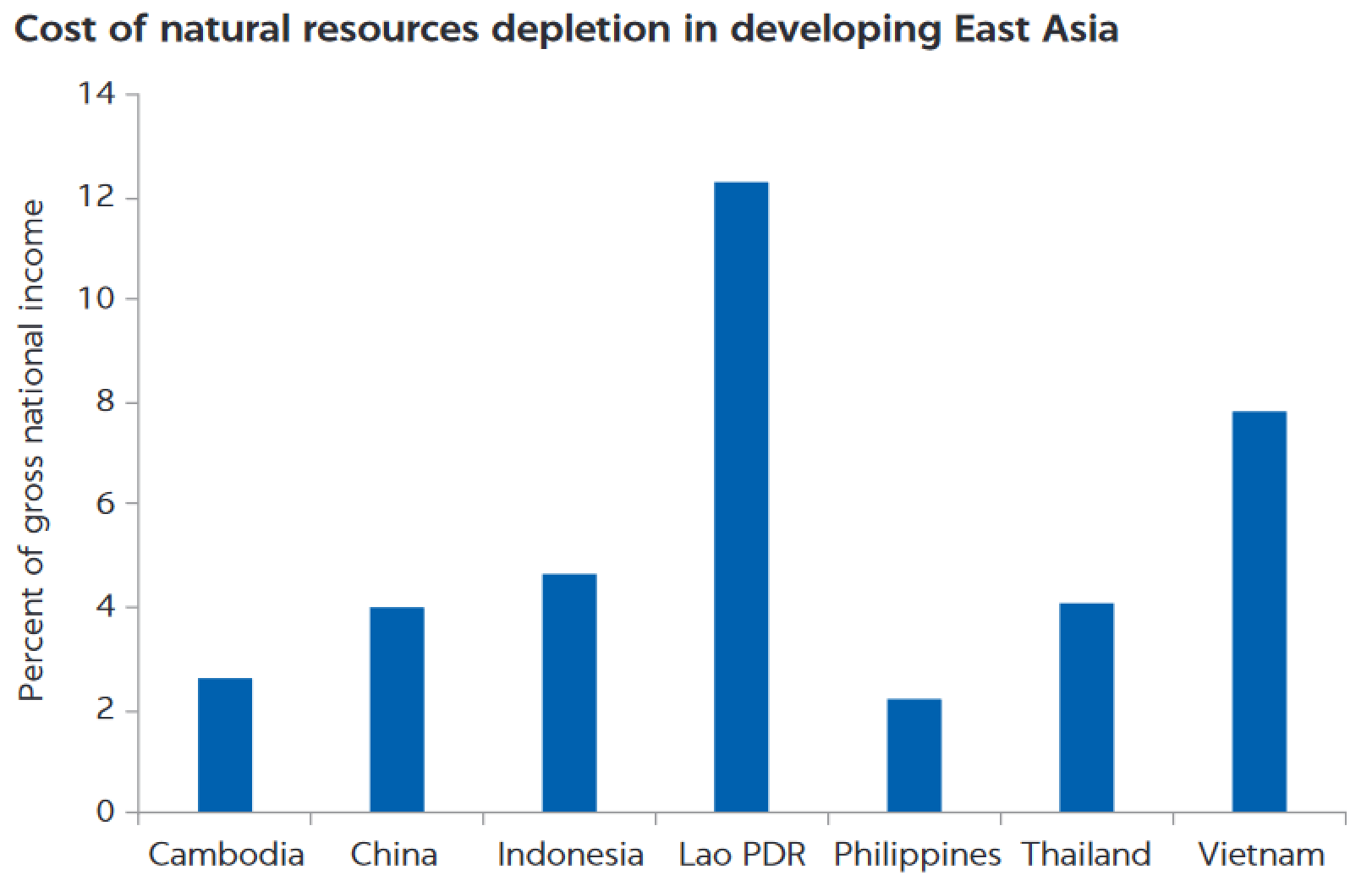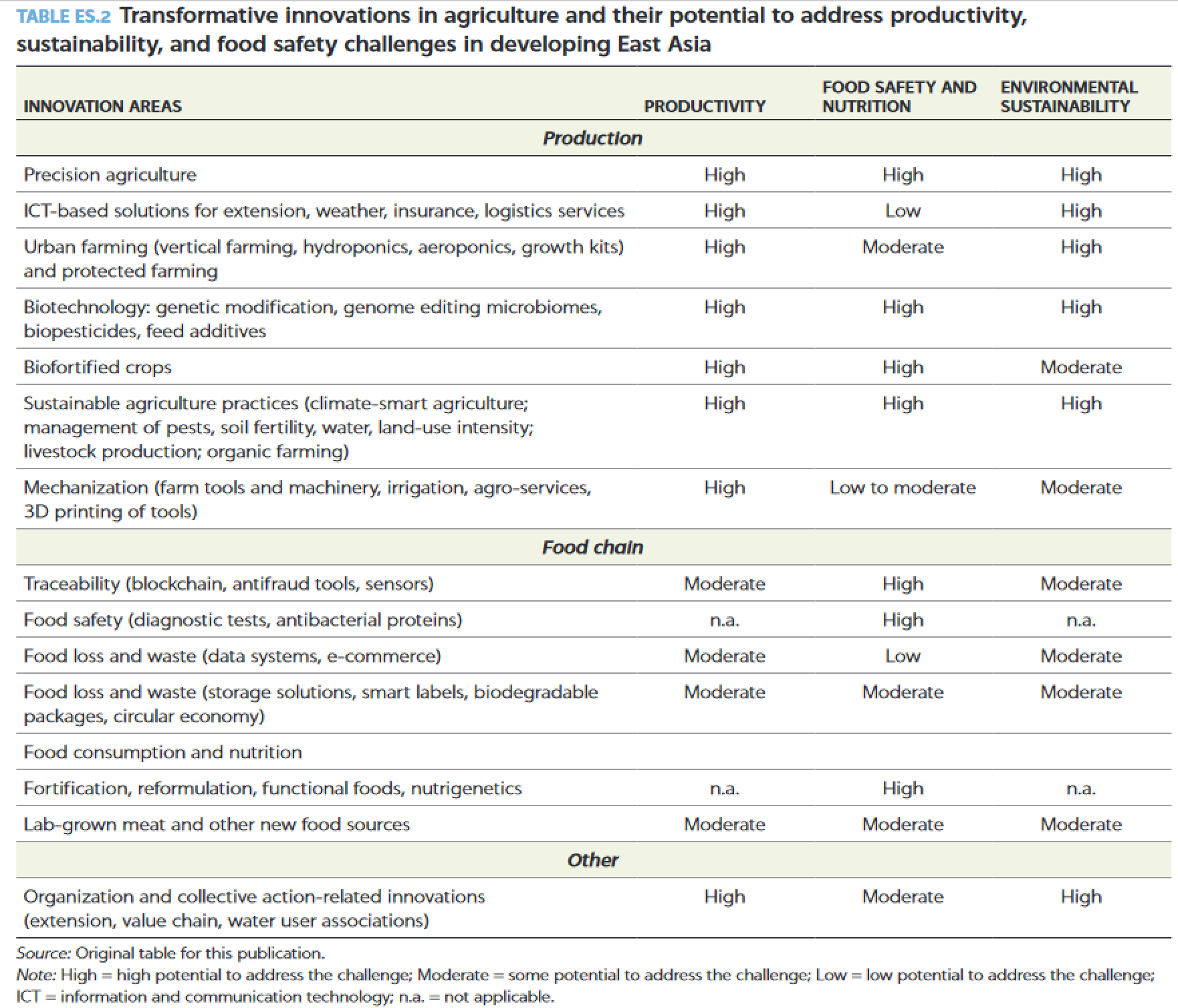Agri-food sectors in the region are experiencing environmental stress and threats to sustainability. A long-standing emphasis on raising production, coupled with constraints on land and water, has had negative effects on the environment. Conversion of more marginal, virgin land for agriculture and over-use of water, agrochemicals, and veterinary drugs, combined with generally poor farming practices, have all had adverse environmental impacts. The effects are vast, including deforestation; loss of biodiversity; soil erosion; pollution of water, air, and oceans (plastics); accelerated greenhouse gas emissions; and water scarcity and salinization. Environmental degradation is negatively affecting agricultural productivity in many places. The expansion and intensification of agriculture has also resulted in habitat degradation and fragmentation, which has amplified the incidence of emerging infectious diseases and zoonoses originating in livestock and wildlife.
The costs associated with environmental degradation are substantial. When considering the productivity losses and cost of treating food-borne diseases, the annual domestic costs of unsafe food to human health and to the economies in developing East Asia amount to more than $45 billion.

This report assesses countries’ preparedness to undertake innovations to address the region’s triple challenge: increasing productivity, improving food safety, and enhancing sustainability. The intent of the report is to identify key constraints for innovation in agriculture and to highlight key areas for policy action.
A significant share of public agriculture spending has gone toward financing input subsidies and price support programs, mainly for cereals, contributing to low adoption of more sustainable farming practices. At the same time, important public goods that would benefit farmers and society, such as extension and environmental services, are undersupplied, reflecting the tight fiscal space of many governments and continuing political support for distortionary input subsidies. This bias explains the relatively limited adoption in most countries of improved, knowledge-intensive farming practices, whether integrated soil-crop management, sustainable rice intensification, or climate-smart agriculture.
A NEW GENERATION OF INNOVATIONS CAN TRANSFORM THE REGION’S AGRI-FOOD SYSTEMS, INCREASING PRODUCTIVITY, SAFETY, AND SUSTAINABILITY
Several transformative innovations hold great potential to increase agricultural productivity, food safety, and agri-food system sustainability, and in doing so build greater resilience to external shocks. Many of these transformative innovations already exist, and the primary focus needs to be on adaptation to local contexts and, subsequently, adoption and diffusion of new technologies and practices. In other cases, further scientific research will be critical, for example with respect to biotechnologies, to improve the resilience of crops to rising climate risk.
The ability of farmers to adopt potentially transformative innovations is influenced by the policy incentives that affect the cost of technology, access to finance, land ownership, ICT connectivity, and the level of farmers’ knowledge and skills. In many contexts, for example, access to finance and land ownership remain barriers to smallholder adoption of precision agriculture or mechanization, which would require some form of land consolidation. Similarly, limited digital-mobile access and affordability may prevent some farmers from adopting ICT-based solutions for extension, weather, insurance, and logistics services as well as from pursuing precision agriculture and emerging e-commerce opportunities.

AN INTEGRATED APPROACH IS NEEDED TO TRANSFORM THE REGION’S AGRI-FOOD SYSTEMS
A country’s agricultural innovation system (AIS) comprises public and private agricultural R&D, extension and education organizations, farms and firms, coordination and governance arrangements, and the wider enabling environment (including regulations, infrastructure, finance) that affect innovation. The strength of a country’s AIS can enable or impede innovation among farmers, firms, and public actors working within a country’s agri-food system. Policy makers in the region have not traditionally taken a holistic view of the issues affecting innovation in agri-food systems.
An AIS approach can support existing efforts to transform agri-food systems by facilitating more integrated arrangements, which can help policy makers identify key constraints to innovation across the agri-food system as well as the policies and resources needed to alleviate them.
This report outlines five complementary areas of AIS investment that will be critical to spurring innovation and transforming countries’ agri-food systems:
1. Strengthening innovation policy and governance
2. Reorienting agricultural R&D to meet emerging challenges
3. Modernizing agricultural extension services
4. Building skills for innovation
5. Strengthening the enabling environment for agricultural innovation
| Year of publication | |
| Geographic coverage | AsiaSouth-Eastern AsiaPhilippinesMyanmarVietnamThailandCambodiaChinaLao People's Democratic RepublicMalaysiaIndonesia |
| Originally published | 24 Jan 2022 |
| Related organisation(s) | World Bank |
| Knowledge service | Metadata | Global Food and Nutrition Security | Research and InnovationSustainable Food Systems | Food systems transformationSustainableAgricultural extension servicesFood systemSmallholder farmer |
| Digital Europa Thesaurus (DET) | environmental impactzoonosisfood safetyCOVID-19research policyinnovationAgricultureCapacity buildingresilience |
